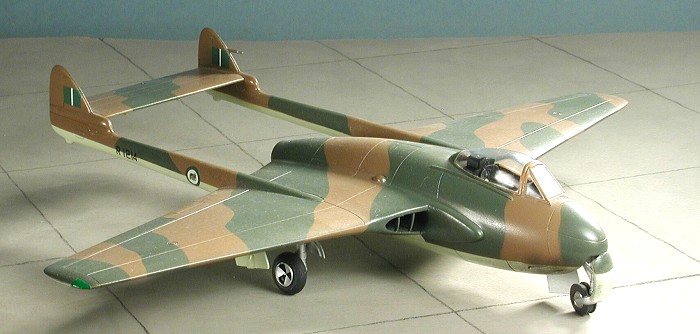
Hobbycraft 1/48 Vampire FB.9
| KIT: | Hobbycraft 1/48 Vampire FB.9 |
| KIT # | ? |
| PRICE: | @$ 13.98 when new |
| DECALS: | Two options, both RAF |
| REVIEWER: | Scott Van Aken |
| NOTES: |

| HISTORY |
The de Havilland Vampire was the second jet engined aircraft to be used by the Royal Air Force during WW II (albeit very briefly). After the war, it served with the front-line RAF until 1955. It also served with foreign air forces, including those of Australia, Finland, France, India, New Zealand, Sweden and Switzerland. Almost 4,400 Vampires were built, a quarter of them under license.
The Vampire began as an experimental aircraft, unlike the Gloster Meteor which was always specified as an interceptor. Given the specification E6/41, design work on the DH-100 began at the de Havilland works at Hatfield in mid-1942, two years after the Meteor.
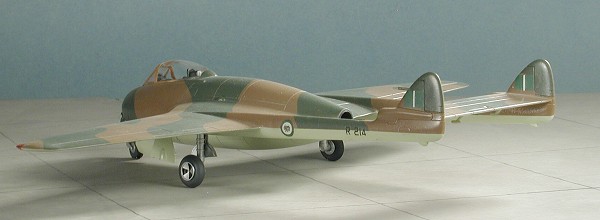 Originally named the Spidercrab, the aircraft was entirely a de Havilland project, and it utilized the company's extensive experience with using molded plywood for aircraft construction . It was the last time composite wood/metal construction was used in high performance military aircraft. It had conventional straight mid-wings and a single jet engine, placed in an egg-shaped, aluminum-surfaced fuselage, and exhausting in a straight line. To protect the rear control surfaces and reduce weight the designers used a distinctive tail with twin booms, similar to that of the Lockheed P-38.
Originally named the Spidercrab, the aircraft was entirely a de Havilland project, and it utilized the company's extensive experience with using molded plywood for aircraft construction . It was the last time composite wood/metal construction was used in high performance military aircraft. It had conventional straight mid-wings and a single jet engine, placed in an egg-shaped, aluminum-surfaced fuselage, and exhausting in a straight line. To protect the rear control surfaces and reduce weight the designers used a distinctive tail with twin booms, similar to that of the Lockheed P-38.
Geoffrey de Havilland piloted the first test flight of prototype LZ548/G on September 30 1943 from Hatfield. Six months behind the Meteor it was enough of a lag for the aircraft to never see WW2 combat. The production Mark I did not fly until April 1945 and most were built by English Electric Aircraft due to the pressures on de Havilland's production facilities, busy with other types. On July 14 1948, Vampire F3s of RAF No 54 Squadron became the first jet aircraft to fly across the Atlantic Ocean. They went via Stornoway, Iceland and Labrador to Montreal on the first leg of a goodwill tour of Canada and the US where they gave several formation aerobatic displays.
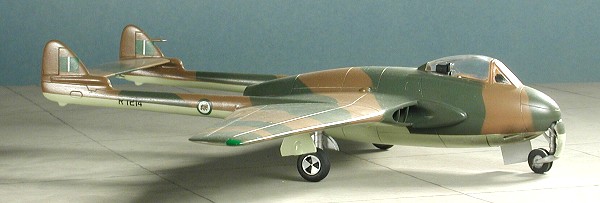 The first engine was a Halford H1 producing 2,100 lb of thrust, designed by Frank Halford and built by de Havilland and later renamed the Goblin. The engine was a centrifugal-flow type, a design soon superceded post-war by the slimmer axial-flow units, and initially gave the aircraft a disappointingly limited range. Later marks were distinguished by greatly increased fuel capacities. As designs improved the engine was often upgraded. Later MkIs used the Goblin 2, the Mk3 onwards used the Goblin III and the final models used the Goblin 3. Certain marks were test-beds for the Rolls-Royce Nene but did not enter production.
The first engine was a Halford H1 producing 2,100 lb of thrust, designed by Frank Halford and built by de Havilland and later renamed the Goblin. The engine was a centrifugal-flow type, a design soon superceded post-war by the slimmer axial-flow units, and initially gave the aircraft a disappointingly limited range. Later marks were distinguished by greatly increased fuel capacities. As designs improved the engine was often upgraded. Later MkIs used the Goblin 2, the Mk3 onwards used the Goblin III and the final models used the Goblin 3. Certain marks were test-beds for the Rolls-Royce Nene but did not enter production.
The Mk5 was navalised as the Sea Vampire, the first Royal Navy jet aircraft. A Vampire had undertaken trials with the Navy in 1945, making a carrier landing on December 3. The RAF Mk5 was altered to extend the aircraft's role from a fighter to a ground attack aircraft, the wings being clipped, strengthened and fitted with hard-points for bombs or rockets. The fighter-bomber Mk5 (FB5) became the most numerous combat variant with 473 aircraft produced.
The final Vampire was the Mk11, a trainer. First flown in 1950, over 600 were produced in both air force and naval models. The trainer remained in service with the RAF until 1966.
History pillaged from the Internet.
| THE KIT |
Hobbycraft has to be congratulated for bringing out a 1/48 Vampire. It is an aircraft type that many have wanted in this scale. Typical of Hobbycraft, it has been done in several different versions, including a two place trainer/night fighter version.
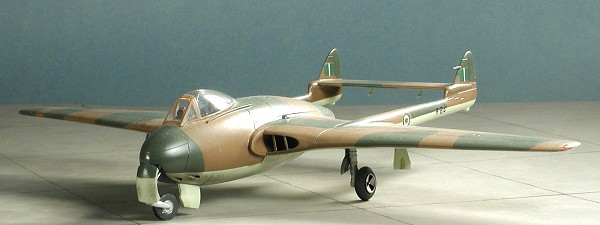 Molded in Hobbycraft's usual medium grey plastic, the parts are well molded with the usual engraved panel lines. The canopy is clear and any cockpit detail can be easily seen. I found little in the way of sink marks and only a few ejector pin marks that were generally easy to clean up or hidden. Now I've got to confess to you that I built this kit several years back and have done this and several other reviews of older kits as part of a 'back-up stash' in case I was unable to finish my weekly kit. The result is that I don't remember everything about what came in the box. There could have been under wing rockets as that would make some sense, but don't remember. I do know that the cockpit is fairly well detailed as are the landing gear.
Molded in Hobbycraft's usual medium grey plastic, the parts are well molded with the usual engraved panel lines. The canopy is clear and any cockpit detail can be easily seen. I found little in the way of sink marks and only a few ejector pin marks that were generally easy to clean up or hidden. Now I've got to confess to you that I built this kit several years back and have done this and several other reviews of older kits as part of a 'back-up stash' in case I was unable to finish my weekly kit. The result is that I don't remember everything about what came in the box. There could have been under wing rockets as that would make some sense, but don't remember. I do know that the cockpit is fairly well detailed as are the landing gear.
Instructions were typical Hobbycraft of the period and that means that while the construction steps were easy to follow, no color information was given during the build. Fortunately, we all know that British aircraft of the period had black interiors and the wheel wells were either the underside color or aluminum, even on basically wooden aircraft like the Vampire. The decal sheet included at least two options, one of them RAF, but like early Hobbycraft sheets, the usefulness of the decals is questionable at best and aftermarket ones are recommended.
| CONSTRUCTION |
Since the aircraft itself is pretty simple, one would think that the build would go quickly. Well, yes and no. You see, this is a 'boomed' aircraft, meaning that it has an abbreviated fuselage and twin tail booms holding the horizontal stabilizer. And the 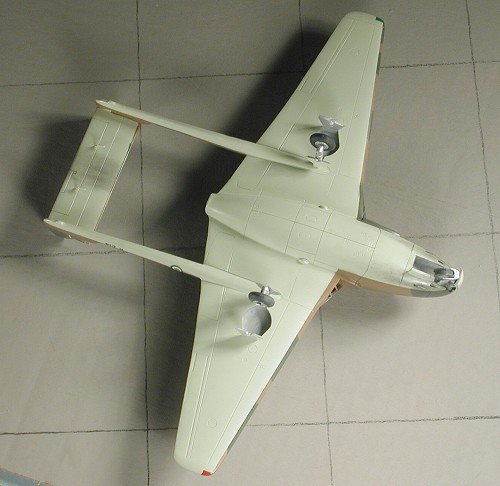 booms are a major problem area with nearly any model of this design. This one being a bit more so as they are flush fit to the end of the wings and I found them to be slightly smaller than the attachment points. I also had difficulty keeping things level, but found that if one assembles the booms and horizontal stabilizer all at the same time, it is easier to have things properly aligned in the end. You have a bit more 'fudge' room while the glue is drying and can apply a bit more to those areas that are giving you trouble. Of course, this makes blending the booms and wings a touch more difficult, but it seems the only real solution.
booms are a major problem area with nearly any model of this design. This one being a bit more so as they are flush fit to the end of the wings and I found them to be slightly smaller than the attachment points. I also had difficulty keeping things level, but found that if one assembles the booms and horizontal stabilizer all at the same time, it is easier to have things properly aligned in the end. You have a bit more 'fudge' room while the glue is drying and can apply a bit more to those areas that are giving you trouble. Of course, this makes blending the booms and wings a touch more difficult, but it seems the only real solution.
I had no trouble building up the cockpit and painting it black. There is room in the nose for the weight that will be needed as those booms tend to make the plane a bit of a tail sitter. Some builders have complained about problems getting the wings to mate properly. This glitch causes a negative diheadral in the wings. I didn't find this to be the case and the wings on my Vampire are level. What I did find is that the shape of the wings is decidedly odd. They just don't look right. They are too broad at the chord and the trailing edge should not be a straight line, but blend in a bit more with the booms.
Another area of concern is that the nose strut does not supply the right 'sit' of the aircraft being a bit too nose high. This can be modified to correct this, but I left it as it was. I also thought that the main wheels were a bit too far from the main gear. Again, something that can be easily fixed, but I left it as it was. About the only modification I made was to drill out the cannon ports.
| COLORS & MARKINGS |
Since I wasn't going to use the kit decals, I had to look around for something else. Way back in the early 1980s, Scale Aircraft Modeling started putting small decal sheets in their monthly issues. This was a great way to be able to do some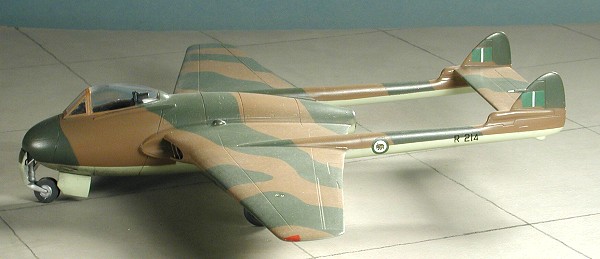 unusual subjects and were a real help. A glitch with their finest sheet on Meteors (the result of not putting wax sheets in there and having all the sheets stick together as a result of Britain's humid climate), ended that, but one sheet that I had was on Rhodesian AF roundels. Perfect for the Vampire in its later years of use with this Air Force. Basically, all that were needed were fuselage (boom) roundels, a set of serials and fin flashes.
unusual subjects and were a real help. A glitch with their finest sheet on Meteors (the result of not putting wax sheets in there and having all the sheets stick together as a result of Britain's humid climate), ended that, but one sheet that I had was on Rhodesian AF roundels. Perfect for the Vampire in its later years of use with this Air Force. Basically, all that were needed were fuselage (boom) roundels, a set of serials and fin flashes.
I painted the model in the disruptive camouflage scheme of Dark Green and Dark Earth uppers and a Sky underside using Gunze acrylics. The gear and wells were painted aluminum using ModelMaster Metallizer. The SAM roundels went on the booms, I used Modeldecal individual letters/numbers for the serial, and for the fin flashes I used green decal sheet cut to size. Then I used a white stripe decal that Scalemaster used to make to complete the flash. This was in the 'bad old days' before the flood of aftermarket as I'm sure there is a full sheet with these markings on it somewhere out there!
Finishing touches on the kit included painting the wing formation lights and adding some exhaust stain on the underside of the horizontal stabilizer and around the guns for Rhodesian Vampires were used in combat.
| CONCLUSIONS |
Well, Hobbycraft had their shot at a series of Vampires and basically blew it. The wings are the wrong shape, the booms too skinny and some will fuss about the fuselage not being the correct profile as well. Aside from these little niggles, the kit does build fairly well and thanks to being shunned by most modelers, it can be found second-hand for a song. Yes, it is a disappointment when a kit has form problems, but the build was enjoyable and for many of us, that is the most important part of things.
October 2004
If you would like your product reviewed fairly and fairly quickly, please contact the editor or see other details in the Note to Contributors.